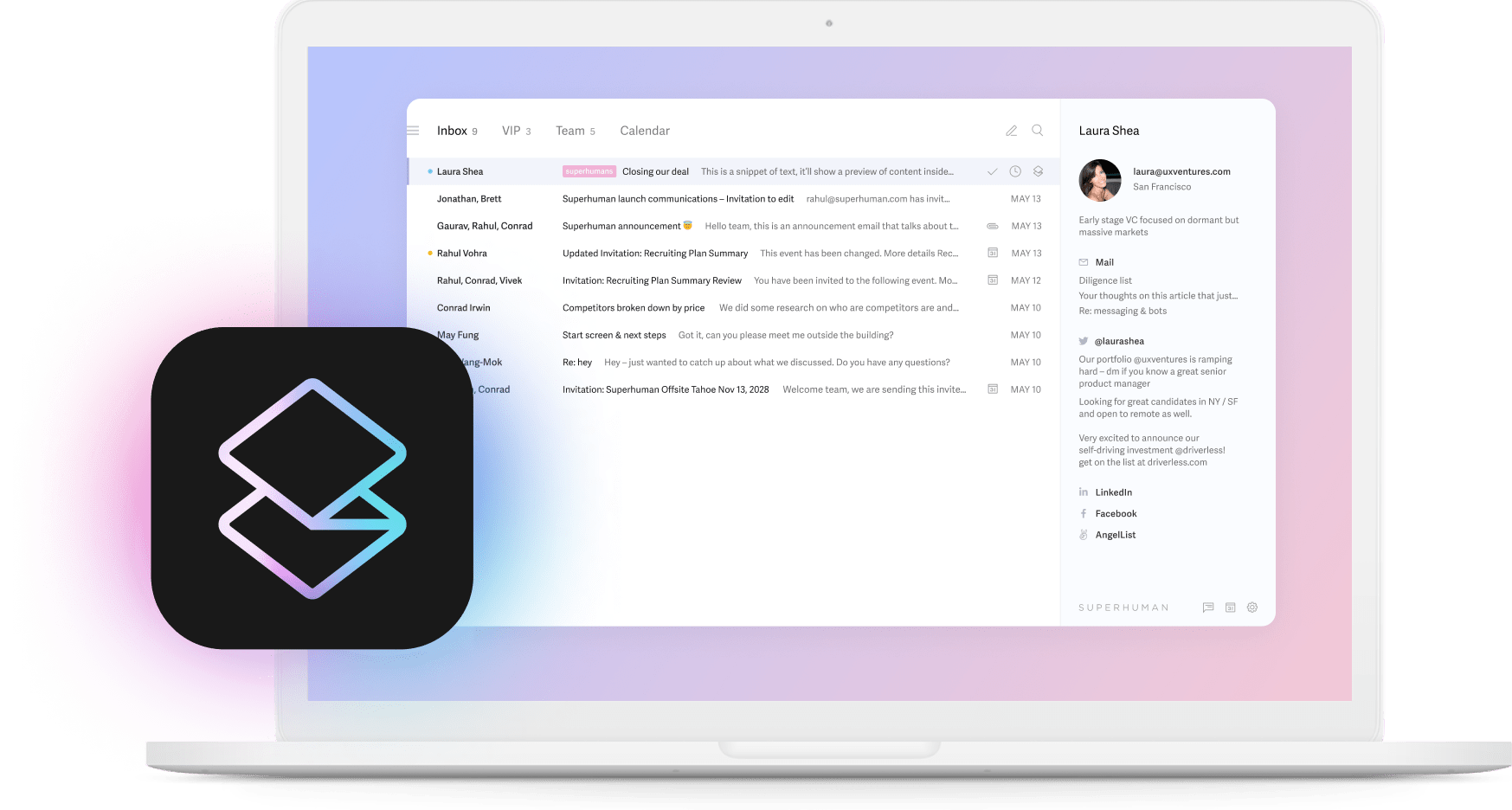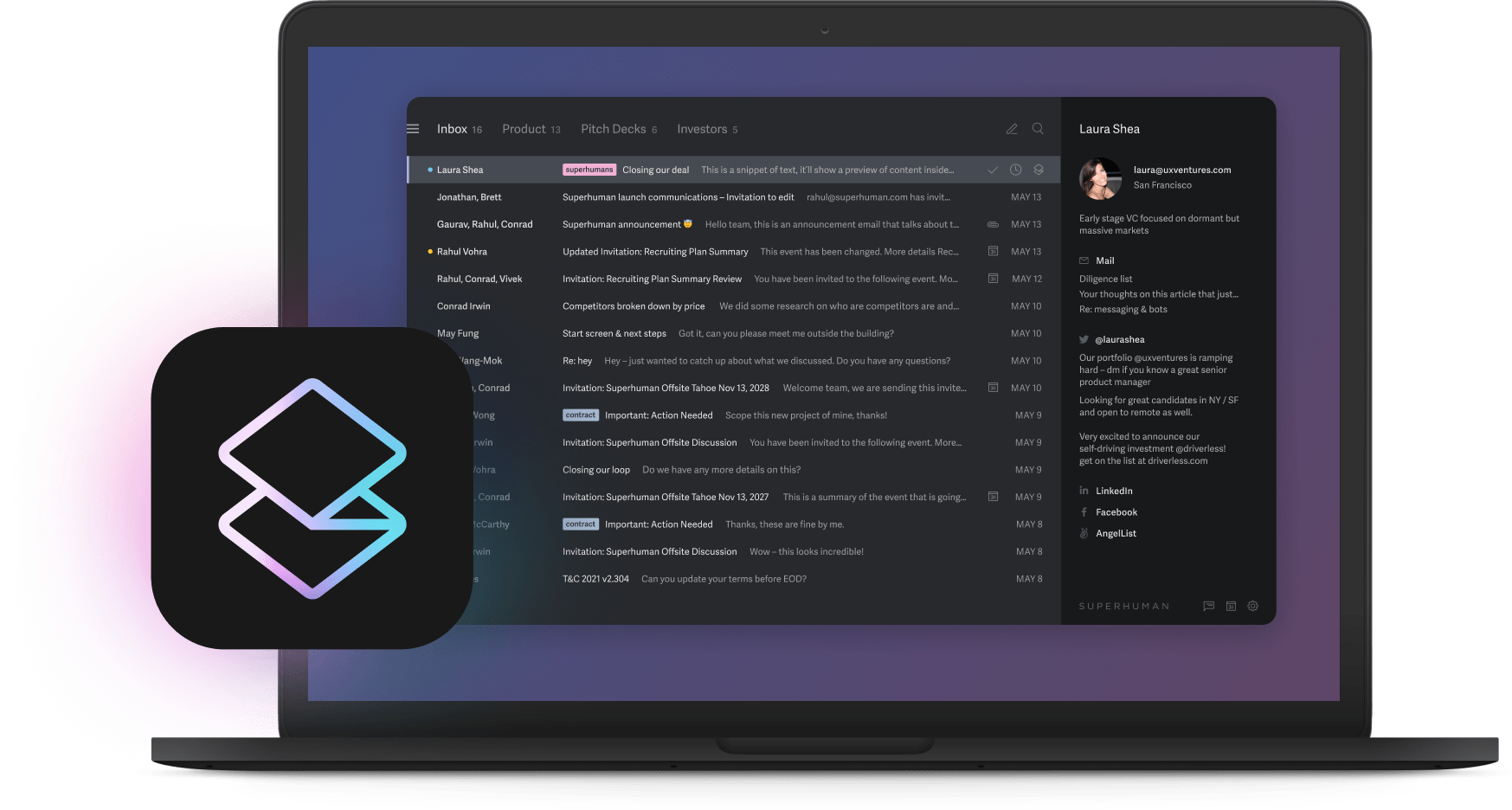
Every day, you spend 300,000 milliseconds making your coffee. You spend 1.2 million ms folding your laundry. You spend 2.1 million ms cooking dinner. And here's the really scary part: the average person spends three hours per day in their email inbox — 10.8 million ms!
What if email could be not only easier and more joyful, but also blazingly fast? That's Superhuman. Email so fast that every action feels instantaneous. Here's how we did that — and everything you need to know about the rule that helped make Superhuman into the fastest email experience in the world.
What is the 100ms rule?
The 100ms rule states that every digital interaction should be faster than 100ms. The concept comes from Gmail creator Paul Buchheit, who said that 100ms is the threshold "where interactions feel instantaneous".
The 100ms rule of latency 📐
— Karan Ganesan (@karanganesan) October 19, 2019
The rule states that every interaction should be faster than 100ms. Why? 100ms is the threshold “where interactions feel instantaneous.”
~ Paul Buchheit, Gmail Creator.
Essentially, if you can limit your latency to 100ms or less at all times, your site will feel incredibly fast — like it transmits and displays information instantly.
What is latency?
To understand the 100ms rule, you need to know about latency, a crucial concept when thinking and talking about what makes things "fast" on the internet.
In its most basic terms, latency is the measurement of how long it takes for a request you make on a website to go from you to the server and then back to you.
Latency is often used interchangeably with "bandwidth", but the two things are very different (bandwidth is the maximum amount of data that a site can transfer within a certain amount of time). Low bandwidth can cause low latency, but it's not the only factor that affects response time.
What causes latency?
Determining the cause of a site's latency isn't always easy, but there are a few things that are generally the most common culprits:
- Propagation: how long it takes information to travel.
- Transmission mediums: the types of cables carrying the information, from copper to fiber.
- Network hops: when digital information moves through a device like a router, bridge, or gateway. The more network hops it makes, the higher its latency will be.
Here's an example of how all three factors work in the real world. Say a piece of digital information is traveling from New York to San Francisco. It takes about 250ms for information to travel from one side of the world to the other. In a vacuum, the speed of light between New York and San Francisco is about 14ms. This is the propagation.
On a fiber cable, information needs about 21ms to travel from New York to San Francisco. But not all homes and businesses are equipped with fiber — many use existing wiring like coaxial cables and copper. And that's for hardwired connections. 4G can add up to 100ms in latency to every information transfer. That's why, when information travels long distances, the last mile tends to take the longest — because of the transmission mediums.
Finally, as the info travels, it moves through different routers, gateways, and bridges. It may be rerouted by VPNs. It can be difficult to determine or control how many devices information needs to travel through, but the higher the number, the longer the process will take. Information that travels 100 miles but moves through five devices will take longer than information that travels 3,000 miles but only moves through two devices. These are network hops.
How do you reduce latency?
There are many great resources out there about how to speed up a webpage. (And there are a few things about Superhuman that are unique in contributing to our speed...see more on this below!)
Just as important as how we achieve extreme speed, is why.
Why did we try so hard to create the fastest email client in the world? That's where the 100ms rule comes in...
Does the 100ms rule really work?
In a study from more than 10 years ago, Amazon found that every 100ms in latency on their site cost them 1% in sales.
Google has found that every 500ms it takes to generate a search page drops traffic by 20%.
Reducing latency as much as possible is crucial to maximizing web and application performance and meeting user expectations. As the internet has become ubiquitous in nearly every part of our lives, it's also become faster and faster.
Webpages and other tools have gotten faster — lowering people's thresholds for waiting. Users expect things to happen online in real time, and will give up on a page if it doesn't load instantly. In fact, there's even new research that questions whether 100ms is even fast enough!
That's why Superhuman treats the 100ms rule as the maximum, and actually aims for latency less than 50ms whenever possible.
We've been working on a new renderer in @Superhuman that is _dramatically_ faster.
— rahulvohra (@rahulvohra) August 14, 2019
First, we had the 100 ms rule. Then, the 50 ms rule. But our new renderer is so fast, it can show emails in 1-2 Chrome frames! (<32 ms)
Feels incredible, like 0-60 in less than 2 seconds! 🔥🚀😁 pic.twitter.com/YO6SF1mxSW
How the 100ms rule made Superhuman the fastest email experience in the world
When we decided to make Superhuman the fastest email experience in the world, we knew the 100ms rule would be an important part of achieving that goal.
Our approach became two-pronged:
- Measure everything you want to make fast
- Make it fast
The first part is constantly tracking and measuring performance metrics to find things we can make faster and track our progress. The second part involves some general best practices for reducing latency, some Superhuman-specific UI features that make our platform quick and easy to navigate, and a few secrets, of course.
Since Superhuman runs on top of Gmail and Outlook, people often wonder how it can be faster than the Gmail client.
@Superhuman how can you guys be faster than gmail if you are an app built on top of Gmail? Am I misunderstanding? I would understand if you are a separate app, but I think I read that ur a Gmail extension.
— David C Shaheen (@davidcshaheen) February 23, 2022
While it uses the same APIs, it also stores information locally and relies on caching to make sure it can display things quickly. For example, Superhuman keeps a database of your emails stored in your app or browser that can be displayed extremely quickly — even when you're offline.
Superhuman also preloads and prerenders the email threads that you're most likely to view soon.
Superhuman uses minimal animations, so no time is wasted on loading them. Gestures are also made easier or avoided altogether in favor of keyboard shortcuts, which are faster than a mouse in almost all cases. Navigating through your inbox is as fast and easy as a few keystrokes, which creates more streamlined workflows and an overall faster user experience. And Superhuman makes it easy to learn how to do things the fastest way by showing keyboard shortcut hints right in the user interface. Superhuman customers never feel "stuck" because they can always pull up the command library and find exactly what they need, rather than scrolling through menus.
That’s something I often tell people who ask me how @Superhuman is different/better/faster than Gmail: we have a lot of individual features/designs that maybe don’t sound life changing on their own, but add up to a whole new experience. https://t.co/fJaCoEAinA
— Tim Boucher (@t_13_r) October 3, 2019
Here are some of the superpowers that help make Superhuman so fast:
- Keyboard Shortcuts: every action has a blazingly fast shortcut that makes it just a tap away.
- Superhuman Command: tap Cmd+K to find what you need in seconds when you don't know the shortcut.
- Split Inbox: split out messages from your team, VIPs, and other important senders so you can focus on your most important messages.
- Remind Me: snooze messages until you're ready to respond, and keep your inbox empty in the meantime.
- Snippets: instantly insert lines, paragraphs, or even whole emails with just a key command.
- Instant Intro: say thank you, move to BCC, and start responding, all in an instant.
- Quick Links: insert hyperlinks instantly.
- Quick Quote: easily reply to "thread-within-a-thread" emails.
- See Your Day: your entire schedule, at a glance, without leaving your inbox.
- Select All from Here: select all your messages from a specific point in your inbox, or all the messages past the horizon, and snooze them or mark them as Done.
- Unsubscribe: remove yourself from unnecessary email lists with just a press of a key.
- Block: block specific senders or domains and free yourself from spam.
Finally, Superhuman uses its fast and minimal UI to help you stay focused on processing your email, which helps you get things done much faster.
Unlike other email clients, speed is a built-in part of the Superhuman experience. In fact, Superhuman customers report saving an average of three hours per week on email.
Ready to see why Superhuman is the fastest email experience in the world? Get Superhuman today.




